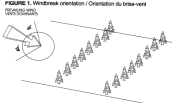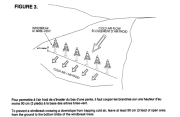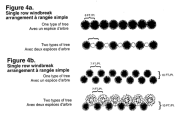A.4.0
A.4.0
In many crops, windbreaks have been shown to improve the climate in the field by increasing temperature and humidity, improving the water balance, and by reducing erosion, pesticide drift and mechanical damage to the crop. The value of windbreaks in wild blueberry production has been recognized in Québec, where they are being planted to control soil erosion. For wild blueberries in New Brunswick, there are two major areas that show great promise for reducing wind speed by windbreak shelters: firstly, improved pollination; and secondly, improved snow trapping to reduce winter damage. The potential impact on yield through improved pollination is especially high in large exposed fields and in areas where bee populations are low. The ability of windbreaks to trap snow is well accepted and would also be useful in large exposed fields in windy areas.
Some disadvantages of windbreaks include the loss of land by the wind-break itself, and some potential for higher concentrations of insects (e.g., fruitfly) and diseases (e.g., Monilinia blight). The latter may be of minor significance to New Brunswick wild blueberry growers, since these disadvantages may be offset by higher levels of productivity and since the net result of the windbreak will be to increase levels of all insects, including beneficial insects and pollinators.
Preliminary trials in northeastern NB have indicated a large response potential in the fruiting year by establishing windbreaks. Further work in windbreaks will continue to evaluate yield, growth in the fruiting and sprouting years, and snow trapping.
Living or Artificial:
There are several alternatives when establishing a windbreak. Artificial windbreaks are expensive but realize an immediate response. They are relatively short, however, and also difficult to support and maintain. Recent experience has indicated that their life expectancy is rather short under our harsh winter conditions. Living windbreaks appear to be the most appropriate alternative for large wild blueberry fields. They are relatively inexpensive to establish, they soon exceed the height of windbreak fencing, and they are self supporting. Species selection and spacing depend somewhat on how fast a grower wants an effective response, how much land is to be given over to the windbreak and how much money is available to purchase and plant trees.
How windbreaks work:
Windbreak effectiveness is a function of the height of the windbreak and its density or porosity. The taller the windbreak the greater the horizontal distance affected on both sides of the windbreak. A very dense windbreak will result in a greater reduction in wind speed, but only for a short horizontal distance from the base of the windbreak. A more porous windbreak will offer a smaller reduction in windspeed, but protect for a longer horizontal distance from the base of the windbreak. Studies have indicated that the best compromise for wind reduction AND snow trapping is from 50 to 80 % open, with snow trapping being favoured by the higher range. These porosities can be attained by including deciduous trees in the windbreak. A well designed windbreak will permit an effective wind speed reduction distance of 10-20 times the height of the trees on the leeward (downwind) side.
Several other factors will have an impact on the effectiveness of a windbreak. These are: orientation, length of the windbreak, avoidance of frost trapping, species selection, and planting and maintenance.
Prevailing winds and windbreak orientation:
Ideally, windbreaks should be located at right angles to the prevailing wind direction, however 45o to either side of this orientation can still provide reasonable protection (see Figure 1.) In most of New Brunswick, the prevailing winds are from the southwest during the summer, and from a westerly direction in winter. A north/south orientation should be suitable for many New Brunswick situations, though the final determination should be based on knowledge of the local conditions. Also, the orientation of the windbreak will depend upon its purpose, whether to improve growing season conditions or to trap snow for over-wintering protection.

Length of windbreak:
The windbreak should be long and continuous, at least 40 times as long as it is high. This minimizes the edge effect around the two ends of the windbreak. When an opening is present, winds will accelerate through the opening, removing snow or creating higher wind speeds that may adversely affect pollinators and/or crop growth.

Avoid forming a frost pocket:
A windbreak must be located as to avoid trapping cold air. Cold air runs downhill and accumulates as would a liquid in depressions or next to obstructions. Permit cold air to drain to a safe lower location by leaving an open pathway through a forested area of at least 15m (50 ft.) at the bottom of a slope. This permits the cold air to drain away from the wild blueberry site. A windbreak can also be used to deflect cold air from flowing onto a site from surrounding higher land (see Figure 2.). The windbreak should be angled to deflect the cold air away from and around the fields to a lower location where it will not damage the crop. In instances where single or double row windbreaks are trapping cold air on a down slope, it is best to remove tree limbs from the bottom of the trunks to permit cold air to move away from the crop. At least 90 cm (3 feet) of cleared area from the ground up is recommended (see Figure 3.).

Windbreaks should be carefully planted and given every opportunity to become well established. In most agricultural situations, windbreaks are established in 10 foot wide rows which are tilled prior to planting. In the drier, less fertile wild blueberry fields, it may be preferable to plant trees directly into the wild blueberry sod ten days after spot killing with Roundup an area one foot in diameter around where each tree will be planted. If the area has already been pruned, the trees will of course have to be planted directly into the sod, without the Roundup treatment. Trees will establish best if planted in the early spring, though a late fall planting is a good alternative. Summer planting should be avoided, since the sunlight is intense and the water demands on plants which have leafed out is quite high.
Windbreaks can be established either from containerized seedlings or from bare-root plants (purchased from a nursery or transplanted from the wild). Using two to four year old trees will of course help to establish the windbreak more quickly, but this will cost more. A good compromise for a mixed windbreak would be to use containerized seedlings of a fast growing species like hybrid poplar with older, bare-root plants of a slower-growing conifer, such as jack pine.
It is best to have container plants well watered prior to transplanting. There is a bit more flexibility in the time at which these trees can be transplanted, but they will perform best if they are transplanted in the early spring or fall. Planting is aided by a tree planter and consists of depositing and digging in the plug into the hole created by the planter.
The roots of bare-root plants must be kept moist at all times following their harvest from the nursery or the wild. They should not be exposed to the wind or the sun, and should be kept in a dark, cool place if they are not transplanted immediately. The best day for transplanting is a cool overcast day. For planting, the trees should be removed one by one from their bucket or their burlap, so as not to suffer from exposure. When planting, a hole one third larger than the root system should be dug, in order to spread out the roots and to avoid rolling them. The trees are transplanted into the soil up to the same level at which they were dug (area above roots where the bark changes color), and as straight as possible. It is best if the trees are watered in and if the soil which is worked in around them is neither too compact nor full of air pockets.
Windbreak trees should receive water for the first few weeks after transplanting. Following this, it is weed control which will most affect the planting. It is important to control weed competition for the first three years. Individualized cardboard mulches could help achieve this.
Many potential windbreak species are susceptible to VELPAR during the establishment years (Table 1). Wherever possible, direct sprays should be avoided. It would be best to mow the windbreak area, rather than treat it with VELPAR. If necessary, spot treatments and/or reduced rates of the herbicide would be advisable.
Roundup may be sprayed over rows of coniferous trees only, provided that the trees are hardened when the spray is applied (this occurs by early September in New Brunswick). Caution should be taken to minimize contact with blueberry plants when using Roundup, since the herbicide is translocated through the plant and will kill the plants with which it comes in contact. Use of a backpack sprayer, a wick-wiper or directed sprays with shields should help achieve this. For deciduous tree plantings, Roundup may also be used, but the spray should not come in contact with either the foliage or the young bark.
With proper spacing, thinning and pruning will be minimal. The species and spacing listed in Table 1 and below should provide effective windbreak coverage. Other species of similar heights and crown spread could be used provided they are hardy enough for your location. The best guide to tree adaptability for your area are the native and introduced species that are successfully growing there already.
Several tree species serve as excellent windbreaks (Table 1). Low maintenance, fast growth and longevity are all desirable features. Trees have the disadvantage of requiring time to grow to an effective height. However, they are much cheaper to establish initially. Depending upon the soil and climate conditions of an area, the tree species listed do well in New Brunswick. The value of the windbreak beyond its wind reduction capabilities should be considered: i.e. wood production, or aesthetic value.
Single row windbreaks appear to be the most effective combination of windbreak coverage and land given up from crop production (see Figure 4a.). However in areas where winds are very strong, and land is not limiting a double row windbreak can be more effective at permitting the windbreak trees themselves to become established. Usually in double row windbreaks the rows are staggered (see Figure 4b.)
Single or double row windbreaks can use the same or different species. In double rows, a fast growing deciduous tree can help a slower growing conifer to get established more quickly. In this instance, the deciduous species is planted in front of the coniferous one in the direction facing the wind.
The species in Table 1 are well adapted to certain NB growing conditions and two schedules are proposed.
Schedule A would see an effective response time of five years from planting. Under this schedule, the trees would be planted with 210 feet between the successive windbreaks. After ten years, or when the windbreak density is too high, every second tree within the row could be removed.
Schedule B would see an effective response time of ten years from planting. This schedule would have 420 feet between the successive windbreaks. After ten years, or when the windbreak density is too high, every second tree within the row could be removed.

| Table 1. Characteristics of trees which could be used for windbreak plantings in wild blueberry fields. | |||||
| Species | Growth rate |
Relative | Avantages | Disadvantages | Comments |
| Conifers | |||||
| Jack pine | medium | medium | - adapted to blueberry soils & dry conditions | - relatively low value at maturity - rated Velpar -susceptible |
|
| Red pine | medium | tall | - adapted to blueberry soils & dry conditions - rated very tolerant of Velpar |
- low intolerant for wetter areas | |
| White spruce | medium | tall | - good adaptability - relatively valuable |
- intolerant of moisture extremes | - rated intermediate in susceptibility to Velpar |
| Red spruce | medium | tall | - good adaptability - good for drier, more fertile sites |
- rated intermediate in susceptibility to Velpar | |
| Larch | medium fast | medium | - good winter porosity - tolerates wetter sites - low disease & insects |
-rated Velpar -susceptible | -requires excellent weed control |
| Deciduous* | |||||
| Hybrid poplar | fast | tall | - can grow 7 feet per year if planted in soil with a high water retention capacity and a pH higher than 5.0 | - relatively short-lived - more costly unless cuttings are used - not recommended in very sandy soils with a low pH. |
- good nurse tree - pollen source for bees - will require pruning - may need protection from rodents - rated intermediate in susceptibility to Velpar - so aggressive that it should be alone in a row |
| White birch | medium | tall | - well adapted - good winter porosity |
- pollen source for bees - may require pruning - may need protection from rodents - rated intermediate in susceptibility to Velpar |
|
| Red maple | medium | tall | - good permanent windbreak - good winter porosity |
- more-costly - large crown |
- will require pruning - may need protection from rodents - rated intermediate in susceptibility to Velpar |
| * Trials conducted on a sandy soil with a low pH have shown that coniferous species grow more rapidly, and are therefore highly recommended. Alternating these with deciduous species is acceptable, but deciduous species alone would not be desirable. | |||||
REFERENCES:
Prepared by George Read, P.Ag., Agroclimatologist, John Argall, P.Ag., Provincial Blueberry Specialist, and Gaétan Chiasson, P.Ag. Horticultural Specialist, N.B. Department of Agriculture & Rural Development
Revise 1996